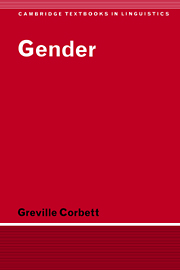Book contents
- Frontmatter
- Contents
- List of figures
- List of tables
- Preface
- List of abbreviations
- 1 INTRODUCTION
- 2 GENDER ASSIGNMENT I: SEMANTIC SYSTEMS
- 3 GENDER ASSIGNMENT II: FORMAL SYSTEMS
- 4 THE PSYCHOLINGUISTIC STATUS OF GENDER ASSIGNMENT
- 5 GENDER AGREEMENT
- 6 ESTABLISHING THE NUMBER OF GENDERS
- 7 TARGET GENDERS: SYNCRETISM AND ENFORCED GENDER FORMS
- 8 HYBRID NOUNS AND THE AGREEMENT HIERARCHY
- 9 GENDER RESOLUTION RULES
- 10 GENERALIZATIONS AND PROSPECTS
- References
- Author index
- Language index
- Subject index
7 - TARGET GENDERS: SYNCRETISM AND ENFORCED GENDER FORMS
Published online by Cambridge University Press: 05 June 2012
- Frontmatter
- Contents
- List of figures
- List of tables
- Preface
- List of abbreviations
- 1 INTRODUCTION
- 2 GENDER ASSIGNMENT I: SEMANTIC SYSTEMS
- 3 GENDER ASSIGNMENT II: FORMAL SYSTEMS
- 4 THE PSYCHOLINGUISTIC STATUS OF GENDER ASSIGNMENT
- 5 GENDER AGREEMENT
- 6 ESTABLISHING THE NUMBER OF GENDERS
- 7 TARGET GENDERS: SYNCRETISM AND ENFORCED GENDER FORMS
- 8 HYBRID NOUNS AND THE AGREEMENT HIERARCHY
- 9 GENDER RESOLUTION RULES
- 10 GENERALIZATIONS AND PROSPECTS
- References
- Author index
- Language index
- Subject index
Summary
We have distinguished the groups into which nouns can be divided (controller genders) from the sets of markers (target genders) which appear on agreeing elements. Nouns are assigned normally to a single gender, while agreeing elements or targets have more than one gender form, and the selection of the appropriate form depends on the gender of the controller. It is interesting topics concerned with target tenders which are the focus of this chapter. First we take up from the preceding chapter the question of the interaction with number, and the types of syncretism which arise (section 7.1). Then we consider the form of gender agreement used when the normal conditions for agreement are not met and so gender agreement becomes a problem. This question is covered in two sections: neutral agreement in section 7.2, and gender agreement with noun phrases involving reference problems in section 7.3. Discussion of inconsistent patterns of agreement is reserved for the following chapter.
Gender and number
It has already become apparent that number enjoys a special relationship to gender. We saw examples in the last chapter where an agreement class which was based on a difference in agreement in one morphological case was not then recognized as a gender (but as a subgender); on the other hand, agreement classes based on a difference in number were recognized as genders.
- Type
- Chapter
- Information
- Gender , pp. 189 - 224Publisher: Cambridge University PressPrint publication year: 1991



